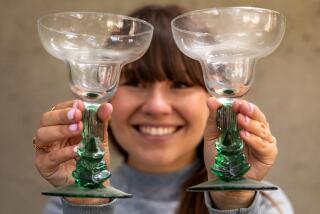Sotheby’s Marion: Any Number Can Play the Auction Game
- Share via
NEW YORK — “I think everyone who has the means should be interested in collecting,” said Sotheby’s chairman John L. Marion.
Everyone? Is this man greedy or what?
As Sotheby’s premier auctioneer in New York, Marion has knocked down the world’s three most expensive paintings: Vincent van Gogh’s “Irises” ($53.9 million), Pablo Picasso’s “Yo Picasso” ($47.9 million) and Picasso’s “Au Lapin Agile” ($40.7 million). He has also sold the three priciest works by living artists: Willem de Kooning’s “Interchange” ($20.7 million) and Jasper Johns’ “False Start” ($17 million) and “Two Flags” ($12.1 million).
But Marion is not content.
Because these big sales get all the press, they lead to the misconception that auctions are a sport for the ultrarich, he said in a recent interview. In fact, more than half of the 200,000-plus lots sold in a year at Sotheby’s go for less than $5,000; a quarter of them sell for under $1,000.
Marion cites these figures repeatedly in “The Best of Everything: The Insider’s Guide to Collecting--for Every Taste and Every Budget” (Simon & Schuster: $19.95), a new book he wrote with Christopher Andersen. While the book is well stocked with anecdotes about the rich and famous, the central message is that you don’t have to be Malcolm Forbes to become a smart player in the auction game.
And smart is definitely the operative word here. “Do your homework,” Marion counsels in one chapter: “Check out the auction house’s reputation,” “study the catalogue,” “check out the merchandise,” “ask the experts,” “attend an auction just to observe.”
He also discusses nine criteria for assessing value: authenticity, condition, rarity, historic importance and provenance, size, medium, subject matter, fashion and aesthetic quality.
Furthermore, Marion exhorts readers to “set a limit” on the amount they will bid before setting foot in an auction room. “Buying on impulse is the single biggest mistake any collector can make,” he writes.
If this is unexpected advice from a man who wants everyone to collect the things that Sotheby’s sells, it’s actually good for business. Sophisticated buyers are the best auction customers in the long run. They don’t stop buying when their homes are furnished. They refine their collections, branch out, trade up and believe their acquisitive passion improves their quality of life.
In short, they become connoisseurs who reap the rewards of making educated decisions. And in collecting, “knowledge is truly power,” Marion said.
Why buy a new rug or piece of furniture when for roughly the same price you can have a more appealing old one that is likely to rise in value, he asked. If you build a coherent collection of things you love, you will be surrounded by objects that have “special meaning” because you took the trouble to find them and learn about them.
But what’s available to the aspiring collector who lacks Donald Trump’s bank account? Marion lists African and Latin American art, American furniture, English salt-glazed stoneware, classic cars and the whole field of collectibles among “best bets” in his book.
Collectors don’t have to buy at auction, but Marion said that they are missing high-quality objects and educational opportunities if they don’t.
“Education is the prime reason for our success,” Marion said. Dealers used to be the primary educators of collectors, but now the major auction houses have taken over part of that role by publishing catalogues, making appraisals and offering a range of customer services, he said.
As collectors have multiplied, they have edged dealers out of auctions. While dealers once bought 60% of the goods offered at a typical auction and added these treasures to their inventories, they now purchase about 40% and many of those sales are ordered by specific clients.
Despite the participation of more and more people, misconceptions about auctions persist, Marion said, and that’s what persuaded him to write a book. He wants his readers to know that you don’t have to spend a lot of money to buy at auction, you can walk in off the street, you can ask questions without fear of ridicule and you can understand what’s going on.
But what if you sneeze, scratch your nose or wave at a friend? Will the auctioneer think you are bidding on a Renoir? “Only if you are Norton Simon.”
More to Read
Sign up for our Book Club newsletter
Get the latest news, events and more from the Los Angeles Times Book Club, and help us get L.A. reading and talking.
You may occasionally receive promotional content from the Los Angeles Times.










